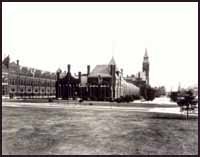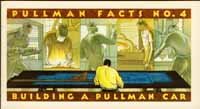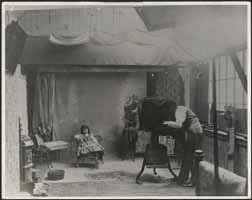Pullman Photographers
You are at Home -> The Pullman Company -> The Photographers of PullmanThe Photographers of Pullman
Since long life is denied, we should do something to show we have lived.Wylie Dennison, 1888 During the early Pullman era, there were several local photographers hired by George Pullman to document his factory, town, and workers. Often the photographers also worked in the factory and/or did photography on a part-time basis. Pullman understood the important role photography could play in marketing his sleeping cars. He used it to create desirability and make his name a household word. The information presented here was excerpted from the article "The Pullman Photographers", written by Don Horn. The complete article can be found in Railroad Heritage Magazine, No. 7, 2003.
1870s -- Early 1880s: John Jex Bardwell
Pullman's photographer at the Detroit Shops. Born in London, he came to the U.S. in 1834, was a member of The Detroit Photographic Association and wrote many articles.
1884 -- 1914: H. R. Koopman
Henry R. Koopman was the Pullman photographer of the town and workers. In 1893 he published a book on the town called "The City of Brick". His studio was located at 11106 S. Michigan Avenue in Roseland. From 1918-19, he worked in the Pullman Shops in the shell division. We have many original photographs, studio cards, postcards, etc. by Koopman as well as images of his studio in Roseland.
Early 1880s: J. W. Taylor
J. W. Taylor was a photography studio of nationwide reputation who photographed the Town of Pullman about 1890. Their series of 24 photos was reproduced in the Pullman Civic Organization's reprint of The Town of Pullman by Mrs. Duane Doty in 1974.
1882 -- 1888: T. S. Johnson
Thomas S. Johnson, of Crete, Illinois, was Pullman's first known part-time photographer of the town and railcars. He had studios in the Casino Building and the Arcade Building. He was known for panoramic views from the Arcade Building and portraiture of townspeople. His small book "Picturesque Pullman" had photogravure reproductions.
1888: Wylie Dennison
Dennison was hired on March 26 as the first full-time photographer. He put together the first in-plant Photography Department at the Pullman Palace Car Factory works. This was the beginning of in-plant photography. Before this it had been done in private studios. He began a day book and recorded every photo noting the negative number, description of train car, type of view and lot number. One interior and one exterior view was taken of every passenger and street car produced. He created a captioned and indexed photographic file. The glass plate negatives were 5x8 or 8x10. His signature occasionally appears as W.D..1904 -- 1945: John P. Van Vorst
John P. Van Vorst replaced Wylie Dennison. Van Vorst had worked in 1897 in the Hammer Shop, transferred to the Freight Shop and then the Upholstery Shop before being hired as an assistant photographer in 1904. Mr. Van Vorst retired in 1945, having been the Pullman photographer for 41 years. He lived near 115th and LaSalle in nearby Roseland. He signed his negatives J.P.V.V.
Assistants under Van Vorst
- 1914: C.F.S. -- Clayton Ford Smith -- His initials appear on a few photographs in Sept. 1916.
- 1922: W. J. -- Unidentified, initials appear on photographs on September 25, 1922.
- 1929: E.B.E. -- Unidentified, initials appear on photographs on January 1, 1929.
- 1937: Joseph McAllister becomes assistant to Van Vorst. Started working at Pullman as a spot welder in the Steel Cabinet Shop, enrolled in home study course and learned photography trade.
- 1945: McAllister promoted to Chief Photographer when Van Vorst retires. Melvin C. Horn becomes assistant to McAllister. Horn had worked in Pullman's Calumet Shops and studied photography in the evening.

1946: Ernie Stutkus
Ernie Stutkus joins staff after working for Moffet Studios in Chicago and for Wallinger Studio as a portrait photographer.1949
McAllister, Horn and Stutkus still working together.1950: Melvin C. Horn
Melvin C. Horn becomes photographer in Engineering Dept., Color and Design Division. No further mention of McAllister or Stutkus. In 1951, Horn was promoted to Chief Photographer in Passenger Department. For a short period Tom Considine was his assistant. In 1956, Horns' title changed to Public Relations and Advertising Photographer, and in 1965 his title again changed to Reporter -- Photographer.1966: J. O'Barski
J. O'Barski hired as Chief Photographer. Soon after, photography department was moved to Michigan City Plant.The End
By the early 1970's, the Department was moved to converted brewery in Michigan City. Pullman Graphics was created with office and studio areas for O'Barski, photographer John Knida and g.a. super. Paul Brown. The Chicago Plant closed in 1981.THE PULLMAN HISTORY SITE

More Information About the Pullman Company
Products from the Factory
Edison Films of Pullman Travel

From A Romance of the Rail, 1903
Other Pullman-Related Sites
- Historic Pullman Garden Club - An all-volunteer group that are the current stewards of many of the public green spaces in Pullman. (http://www.hpgc.org/
- Historic Pullman Foundation - The HPF is a non-profit organization whose mission is to "facilitate the preservation and restoration of original structures within the Town of Pullman and to promote public awareness of the significance of Pullman as one of the nation's first planned industrial communities, now a designated City of Chicago, State of Illinois and National landmark district." (http://www.pullmanil.org/)
- The National A. Philip Randolph Pullman Porter Museum is a 501(c)3 cultural institution. Its purpose is to honor, preserving present and interpreting the legacy of A. Philip Randolph, Pullman Porters, the Brotherhood of Sleeping Car Porters and the contributions made by African-Americans to America's labor movement. ((http://www.nationalpullmanportermuseum.com/)
- Pullman Civic Organization - The PCO is a strong and vibrant Community Organization that has been in existence since 1960. (http://www.pullmancivic.org/)
- Pullman National Monument - The official page of the Pullman National Park. (https://www.nps.gov/pull/)
- South Suburban Genealogical & Historical Society - SSG&HS holds the Pullman Collection, consisting of personnel records from Pullman Car Works circa 1900-1949. There are approximately 200,000 individuals represented in the collection. (https://ssghs.org/)
- The Industrial Heritage Archives of Chicago's Calumet Region is an online museum of images that commemorates and celebrates the historic industries and workers of the region, made possible by a Library Services and Technology Act grant administered by the Illinois State Library. (http://www.pullman-museum.org/ihaccr/)
- Illinois Digital Archives (IDA) is a repository for the digital collections libraries and cultural institutions in the State of Illinois and the hosting service for the online images on this site. (http://www.idaillinois.org/)







